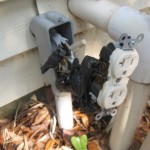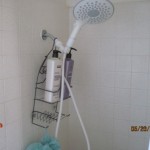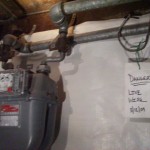The building standards that apply to new construction state in the 2009 IRC that Carbon Monoxide detectors are required on each level AND outside of each sleeping area. A sleeping area refers to a cluster of bedrooms at the end of a hallway, for example. So if a house has the master at one end of the house, and the other bedrooms on the other side of the house, two detectors would be required (give a one story house).
This applies to just about all types of occupancies from single family owner-occupied and rentals, to multi-family housing. If the property is being sold, it must now include a CO Detector(s) if the dwelling has gas appliances, fireplaces, and/or attached garages as described below.
The second part of the law enacts the Carbon Monoxide Poisoning Prevention Act of 2010 which requires that all residential properties, not just those being sold, be equipped with a Carbon Monoxide detector when the property has a fossil fuel burning heater or appliance, fireplace, and/or an attached garage. All single-family homes in structures with 1-4 units (owner or tenant occupied) must be equipped with a detector on or before July 1, 2011.
All other multi-family residential units must be equipped with a detector on or before January 1, 2013, not just those being sold.
For rentals, the Carbon Monoxide detector must be operable at the time the tenant takes possession. A tenant is responsible for notifying the owner or owner’s agent if the tenant becomes aware of an inoperable or deficient carbon monoxide detector within his or her unit. The owner or owner’s agent must correct any reported deficiencies in the carbon monoxide detector and will not be in violation of this section for a deficient or inoperable carbon monoxide detector when he or she has not received notice of the deficiency or inoperability.
17926. (a) An owner of a dwelling unit intended for human occupancy shall install a carbon monoxide device, approved and listed by the State Fire Marshal pursuant to Section 13263, in each existing dwelling unit having a fossil fuel burning heater or appliance, fireplace, or an attached garage, within the earliest applicable time period as follows:
(1) For all existing single-family dwelling units intended for human occupancy on or before July 1, 2011.
(2) For all other existing dwelling units intended for human occupancy on or before January 1, 2013.
(b) With respect to the number and placement of carbon monoxide devices, an owner shall install the devices in a manner consistent with building standards applicable to new construction for the relevant type of occupancy or with the manufacturer’s instructions, if it is technically feasible to do so.
Ingraffia Home Inspections LLC
Lic.# 5198940-10
Phone: (714)371-8422
Certified, Licensed & Insured
www.IngraffiaHomeInspections.com Mark@IngraffiaHomeInspections.com













